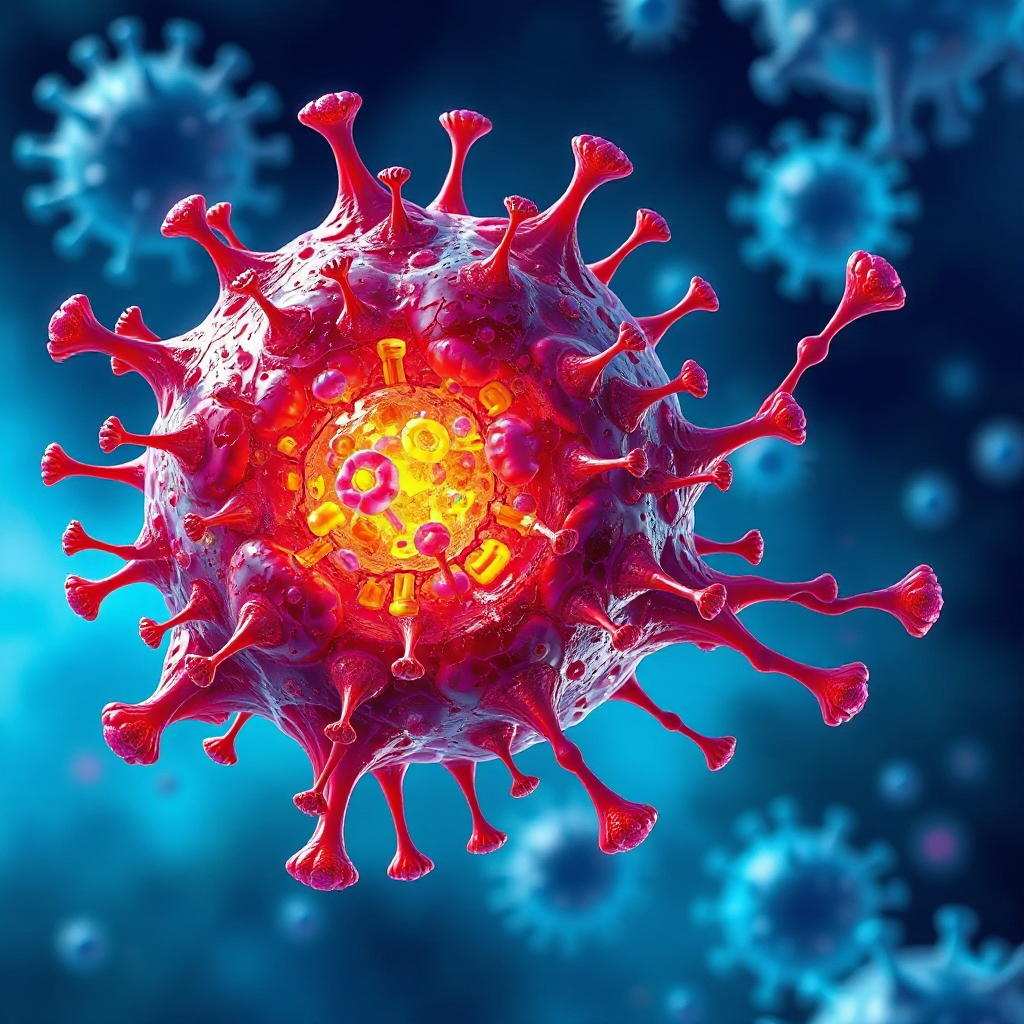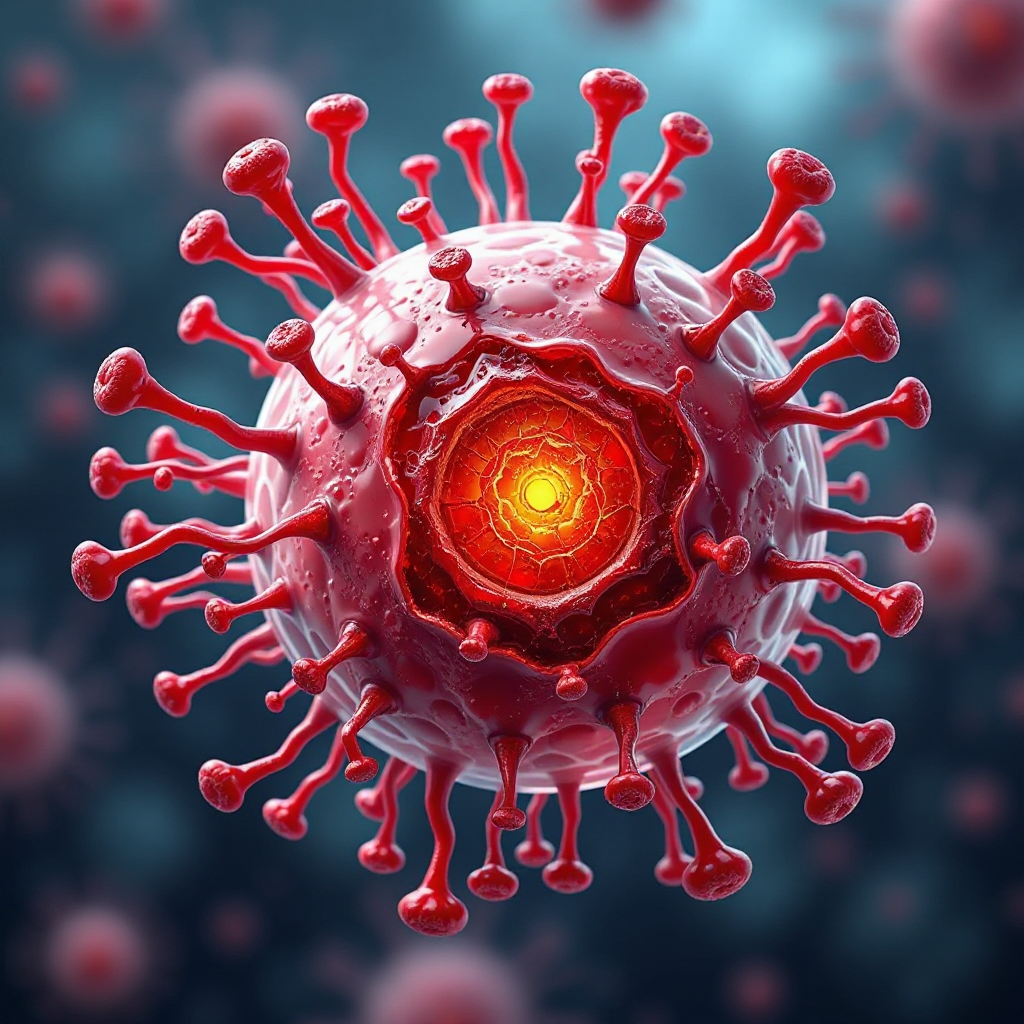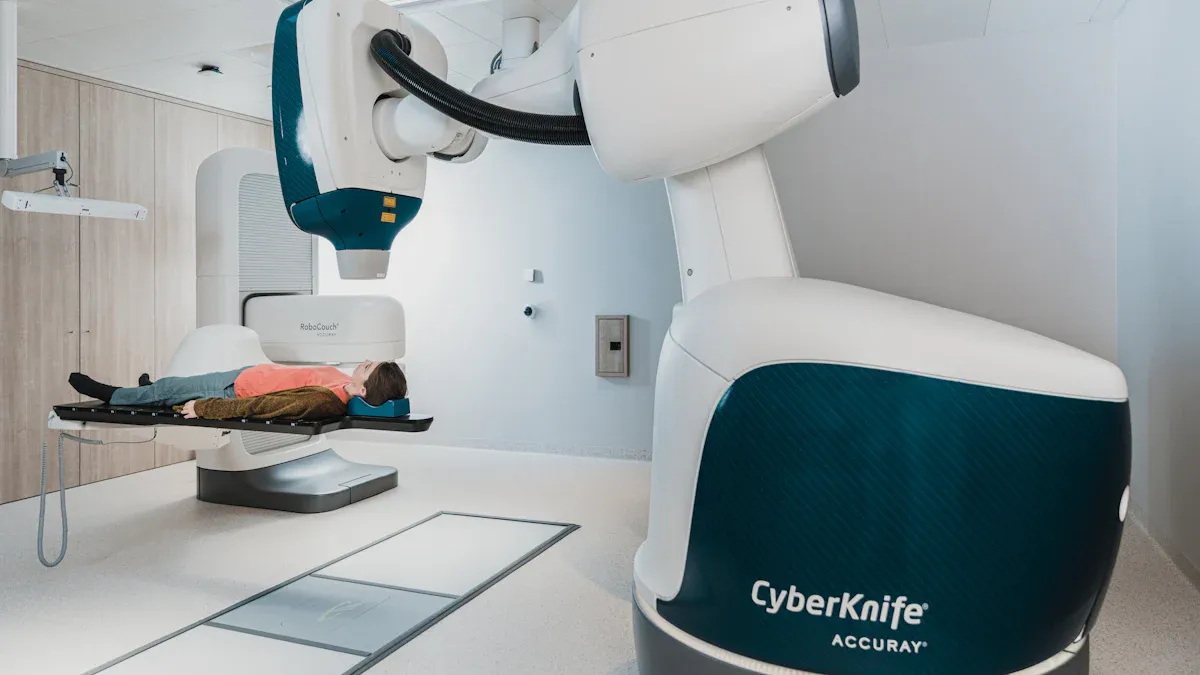What Is Plasmablastic Lymphoma and Why It Matters

Plasmablastic lymphoma is a rare and aggressive form of non-Hodgkin lymphoma. It primarily affects individuals with weakened immune systems, especially those living with HIV/AIDS. This cancer grows rapidly, often leading to a poor prognosis. On average, individuals survive about 32 months after diagnosis, with a median survival of just 1.72 years. Early detection is critical, as the survival rate drops significantly over time. For example, only 54% of patients survive three years, and this decreases to 52.8% at five years. Understanding this disease can help you recognize its risks and seek timely medical care.
Key Takeaways
Plasmablastic lymphoma is a rare and fast-growing cancer. It mostly affects people with weak immune systems, like those with HIV/AIDS.
Finding it early is very important. Symptoms include night sweats, swelling, and sudden weight loss. Getting help quickly can improve health outcomes.
Strong chemotherapy is the main treatment. For HIV-positive patients, using chemotherapy with antiretroviral therapy can help them live longer.
Teaching at-risk groups about this cancer is very important. Learning about symptoms and risks can help people get diagnosed sooner.
See a doctor right away if you notice symptoms. Early diagnosis makes treatment work better and improves life quality.
Understanding Plasmablastic Lymphoma

What Is Plasmablastic Lymphoma?
Plasmablastic lymphoma is a rare and aggressive cancer classified as a variant of diffuse large B-cell lymphoma (DLBCL) by the World Health Organization (WHO). It primarily affects B-cells, which are a type of white blood cell. Unlike other lymphomas, it shows unique features under the microscope. These include plasmablastic morphology, numerous mitotic figures, and minimal expression of CD20, a common B-cell marker. Instead, it strongly expresses plasma cell markers like CD138 and VS38c. These characteristics make it distinct from other types of non-Hodgkin lymphoma.
How It Differs from Other Lymphomas
Plasmablastic lymphoma stands out due to its clinical presentation and molecular profile. It often appears in the oral cavity, nose, or paranasal regions, especially in individuals with HIV. The tumor cells can range from immunoblastic to plasmacytoid in appearance, with monomorphic plasmablastic cells being more common in HIV-positive patients. Unlike plasma cell myeloma, it does not show monoclonal gammopathy. It also has a stronger association with Epstein–Barr virus (EBV) infection compared to other lymphomas. Patients with this condition tend to be younger than those diagnosed with other non-Hodgkin lymphomas.
Who Is Most at Risk?
Plasmablastic lymphoma is most prevalent among immunocompromised individuals. It accounts for about 11% of AIDS-related lymphomas and is more common in adult men living with HIV. However, it can also occur in people with other conditions that weaken the immune system, such as organ transplant recipients or those undergoing immunosuppressive therapy. If you belong to one of these groups, staying vigilant about potential symptoms is crucial for early detection.
Symptoms and Causes of Plasmablastic Lymphoma
Common Symptoms
Plasmablastic lymphoma often presents with symptoms that can be mistaken for other conditions. You might notice painless swelling in your lymph nodes, which is one of the most common signs. Other symptoms include:
Drenching night sweats
Unexplained fever
Fatigue that doesn’t improve with rest
Sudden weight loss without trying
Pain in your chest, abdomen, or bones without a clear cause
Skin rash or persistent itching
Disseminated bone involvement
These symptoms can develop quickly due to the aggressive nature of the disease. If you experience any of these signs, especially if you belong to a high-risk group, seeking medical attention promptly is essential.
Underlying Causes
The exact causes of plasmablastic lymphoma are complex, but researchers have identified several biological mechanisms. For example, the downregulation of B-cell receptor signaling, which is crucial for normal B-cell function, may contribute to the disease. Genetic changes, such as the loss of p16 expression and upregulation of MDR-1, also play a role. Chromosomal translocations and the uniform expression of Notch1 further disrupt normal B-cell activity, leading to the development of this aggressive cancer. These findings highlight how genetic and molecular changes drive the disease's progression.
Risk Factors
Certain genetic and environmental factors increase your risk of developing plasmablastic lymphoma. Genetic alterations in the MYC and PRDM1 genes are significant contributors. If you are HIV-positive, the high incidence of MYC rearrangement linked to viral infections like Epstein-Barr virus (EBV) further elevates your risk. EBV also interacts with immune checkpoints, creating an environment that promotes cancer growth. Understanding these risk factors can help you stay vigilant and proactive about your health.
Diagnosing Plasmablastic Lymphoma
Diagnostic Tests
Diagnosing plasmablastic lymphoma involves a combination of clinical evaluation, imaging, and laboratory tests. Your doctor may start with a biopsy of the affected tissue. This test examines the cells under a microscope to identify the unique features of plasmablastic lymphoma, such as plasmablastic morphology and plasma cell markers like CD138. Immunohistochemistry plays a key role in confirming the diagnosis by detecting specific proteins in the tumor cells. Additional tests, such as PET or CT scans, help determine the extent of the disease. Blood tests may also be used to assess your overall health and rule out other conditions.
Challenges in Diagnosis
Diagnosing plasmablastic lymphoma can be particularly challenging. Its rarity means that many clinicians lack experience with this condition, leading to delays in diagnosis. Differentiating it from plasmablastic plasma cell myeloma is another hurdle. Both diseases share nearly identical immunophenotypic profiles, but they require different treatment approaches. Plasmablastic lymphoma is treated as a subtype of diffuse large B-cell lymphoma, while plasma cell myeloma follows a separate chemotherapy regimen. These challenges highlight the importance of consulting specialists familiar with this aggressive cancer.
Importance of Early Detection
Early detection significantly improves outcomes for patients with plasmablastic lymphoma. Identifying the disease at an early stage allows for more effective treatment and better management of symptoms. The table below highlights factors that influence prognosis:
Prognostic Factor | Impact on Outcome |
|---|---|
Early-stage (stage 1) lymphoma | Better outcome |
EBV infection | Better outcome |
Presence of CD45 protein in cells | Better outcome |
Absence of changes in c-MYC gene | Better outcome |
If you notice symptoms like unexplained swelling or night sweats, seeking medical attention promptly can make a significant difference. Early intervention not only improves survival rates but also enhances your quality of life during treatment.
Treatment Options for Plasmablastic Lymphoma

Chemotherapy and Radiation
Chemotherapy forms the backbone of treatment for plasmablastic lymphoma. Doctors often recommend aggressive regimens to combat this fast-growing cancer. Commonly used regimens include:
Regimen | Components |
|---|---|
CODOX-M/IVAC | Cyclophosphamide, vincristine, doxorubicin, high-dose methotrexate, ifosfamide, etoposide, high-dose cytarabine |
Dose-modified EPOCH | Etoposide, prednisone, vincristine, cyclophosphamide, doxorubicin |
Hyper-CVAD | Cyclophosphamide, vincristine, doxorubicin, dexamethasone, high-dose methotrexate, cytarabine |
Radiation therapy can also play a role, especially for patients with limited-stage disease. Combining aggressive chemotherapy with radiation has shown favorable outcomes in these cases. This approach helps target localized tumors and improves survival rates.
Role of Antiretroviral Therapy
For patients with HIV-associated plasmablastic lymphoma, antiretroviral therapy (ART) offers significant benefits. ART helps restore immune function, which is often compromised in these patients. When combined with chemotherapy, ART has led to complete remission in some cases.
One patient achieved a complete response to ART alone, lasting 14 months before relapse.
Another patient experienced long-term remission after brief chemotherapy alongside ART.
These examples highlight how ART not only supports the immune system but also enhances the effectiveness of other treatments.
Emerging Treatments
Researchers are exploring new therapies to improve outcomes for patients with plasmablastic lymphoma. Promising options include:
Bortezomib: Effective when combined with EPOCH as a frontline treatment.
CD30 monoclonal antibody (Brentuximab): Induces tumor shrinkage in some cases.
CD38 monoclonal antibody (Daratumumab): Activates natural killer cells to attack cancer cells.
MYC protein inhibitor (myci361): Blocks tumor growth and boosts immune response, currently in preclinical trials.
Thalidomide and Lenalidomide: Show potential in maintaining remission or achieving long-term responses.
Immune checkpoint inhibitors (e.g., Nivolumab): Demonstrated partial response in a patient with relapsed disease.
These emerging therapies offer hope for patients, especially those with relapsed or refractory disease. Continued research will likely expand treatment options and improve survival rates.
Why Awareness of Plasmablastic Lymphoma Is Crucial
The Importance of Early Diagnosis
Early diagnosis plays a vital role in improving outcomes for individuals with plasmablastic lymphoma. This aggressive cancer progresses quickly, making timely detection essential. When caught early, treatment can begin before the disease spreads extensively. Early-stage lymphoma often responds better to therapy, increasing the chances of remission. You should pay attention to symptoms like unexplained swelling, night sweats, or sudden weight loss. Recognizing these signs early can lead to prompt medical evaluation and better survival rates.
Challenges in Treatment
Treating plasmablastic lymphoma presents significant challenges. This rare cancer lacks standardized treatment protocols, which complicates care. Doctors often rely on aggressive chemotherapy regimens, but these treatments do not guarantee long-term success. Several obstacles hinder progress in developing effective therapies:
Plasmablastic lymphoma is an aggressive form of non-Hodgkin lymphoma often linked to HIV.
There is no consensus on optimal therapies, leading to inconsistent treatment approaches.
The overall survival rate remains low, with only about 4% of patients surviving beyond three to five years.
Additionally, the rarity of this disease limits research opportunities, slowing the development of new treatments. These challenges highlight the need for greater awareness and investment in research.
Raising Awareness in At-Risk Communities
Raising awareness about plasmablastic lymphoma is crucial, especially in communities at higher risk. Individuals with weakened immune systems, such as those living with HIV, face a greater likelihood of developing this cancer. Educating these groups about the symptoms and risk factors can empower them to seek medical attention early. Community health programs, support groups, and public health campaigns can play a key role in spreading knowledge. By increasing awareness, you can help reduce delays in diagnosis and improve access to life-saving treatments.
Plasmablastic lymphoma is a rare but aggressive cancer that demands attention. You should remember its key symptoms, such as lumps in the oral cavity, nasal tumors causing nosebleeds, or gastrointestinal issues like pain and diarrhea. B symptoms, including night sweats, fever, and weight loss, are also common, especially in individuals with HIV. Treatment often involves intensive chemotherapy regimens like EPOCH or CODOX-M/IVAC, with intrathecal chemotherapy used for central nervous system involvement.
Early detection can save lives. Recognizing symptoms and seeking medical advice promptly improves your chances of effective treatment. Raising awareness in at-risk communities ensures more people can access timely care. If you or someone you know may be at risk, don’t wait—consult a healthcare professional today.
FAQ
What makes plasmablastic lymphoma different from other lymphomas?
Plasmablastic lymphoma grows faster and often affects immunocompromised individuals. It shows unique features under the microscope, like plasmablastic morphology and plasma cell markers. Unlike other lymphomas, it has a strong link to Epstein-Barr virus (EBV) and often appears in the oral cavity or nasal regions.
Can plasmablastic lymphoma be cured?
Treatment can lead to remission, but curing plasmablastic lymphoma remains challenging due to its aggressive nature. Early detection and aggressive chemotherapy improve outcomes. Emerging therapies, like immune checkpoint inhibitors and monoclonal antibodies, offer hope for better long-term results.
How can you reduce your risk of plasmablastic lymphoma?
You can lower your risk by managing conditions that weaken your immune system. For example:
Follow antiretroviral therapy if you have HIV.
Avoid unnecessary immunosuppressive treatments.
Stay vigilant about symptoms like unexplained swelling or night sweats.
Is plasmablastic lymphoma always linked to HIV?
No, while it’s common in individuals with HIV, plasmablastic lymphoma can also occur in people with other immune-compromising conditions. These include organ transplant recipients or those undergoing immunosuppressive therapy. However, HIV-positive individuals face a higher risk.
What should you do if you suspect plasmablastic lymphoma?
Seek medical attention immediately if you notice symptoms like painless swelling, night sweats, or unexplained weight loss. Early diagnosis improves treatment success. A biopsy and imaging tests can confirm the condition, so don’t delay consulting a healthcare professional.
See Also
Exploring Lymphoplasmacytic Lymphoma: Symptoms You Should Know
Key Characteristics of Intravascular Large B-Cell Lymphoma
B-Cell Prolymphocytic Leukemia: A Simple Overview
